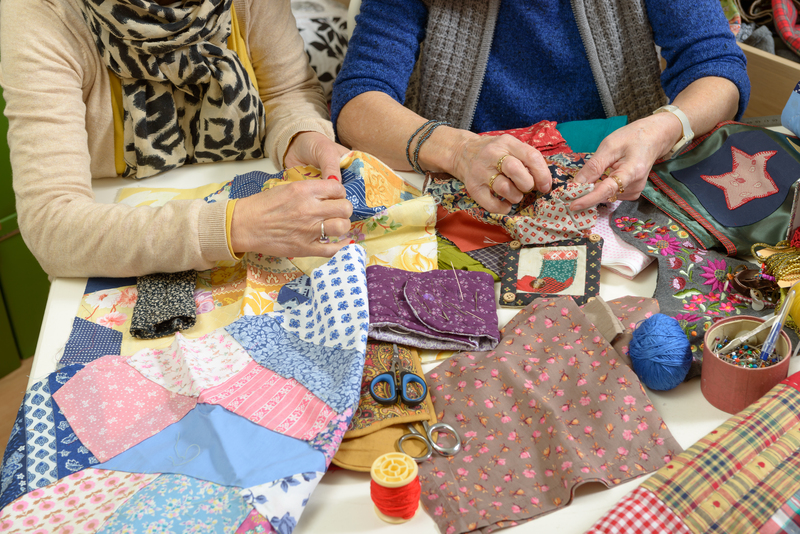Achieve Lasting Tidiness: Strategies for Clutter Control After a Clear-Out
Posted on 02/06/2025
Achieve Lasting Tidiness: Strategies for Clutter Control After a Clear-Out
Congratulations! You've taken the bold step of purging your space and giving everything a fresh start with a successful clear-out. But, as many discover, achieving lasting tidiness is an ongoing journey, not a one-time event. The real challenge lies in maintaining a clutter-free living area and ensuring your home or office remains organized, welcoming, and stress-free. In this comprehensive guide, you'll learn the most effective strategies for clutter control after a clear-out, discover actionable tips, and gain a deeper understanding of how to create habits leading to permanent tidiness.
Why Maintaining Tidiness Matters After a Declutter
While a thorough declutter feels refreshing, the benefits only last if you implement a system for clutter control. People often underestimate the speed at which clutter returns. Without attention and planning, you might find yourself back at square one--overwhelmed by disorganization.
- Reduces stress: Messy spaces can increase anxiety and decrease productivity.
- Saves time: Organized spaces make it easier to find what you need, when you need it.
- Boosts well-being: A tidy environment encourages relaxation and can improve mental health.
- Protects investments: Reducing clutter often keeps possessions in better condition and extends their longevity.

Understanding Clutter: Root Causes and Patterns
Clutter is not simply a physical issue; it's often an emotional or habitual problem. To achieve lasting tidiness, it's crucial to identify why clutter accumulates in your life:
- Sentimental attachment: Holding onto items due to emotional value.
- Uncontrolled consumption: Regularly buying new things without discarding old ones.
- Lack of systems: No designated place for items leads to piles and disorder.
- Busy lifestyle: Not enough time allocated for maintenance.
By addressing the roots of clutter, you can implement strategies that are truly effective for clutter control after a clear-out.
Actionable Strategies for Clutter Control After a Clear-Out
1. Establish 'A Place for Everything'
The foundation of organized living is ensuring each item in your space has a dedicated home. If you don't know where something goes, it's likely to become clutter. When organizing after a clear-out, assign a logical place for every possession according to how often it's used and where it's needed.
- Daily-use items: Store within easy reach--entryways, kitchen counters, or top drawers.
- Occasional items: Allocate higher shelves, closets, or storage bins clearly labeled.
- Specialty or seasonal: Use thoughtful storage solutions, like under-bed containers or garage shelving, and make items each to access for annual use.
Labeling helps everyone in the home or office return things to their proper place, solidifying the habit.
2. Practice the 'One In, One Out' Rule
A classic technique for lasting tidiness, this rule ensures you never exceed your storage capacity. Every time you acquire a new item, commit to removing one of the same type. This prevents accumulation.
- Buy a new shirt? Donate or recycle an old one.
- Upgrade a kitchen appliance? Remove the obsolete version.
Consistency is critical; making this rule a habit will naturally limit the return of clutter over time.
3. Set Up Maintenance Schedules
A well-organized space will eventually unravel without ongoing attention. To maintain clutter control after a clear-out, incorporate tidy-up sessions into your routine:
- Daily: Quick five-minute sweep to return items to their places.
- Weekly: Reset shared areas like kitchens or living rooms on a set day.
- Monthly: Deep-er organization--tackle 'hot spots' like junk drawers or entryways.
- Seasonally: Reassess items for donation, sale, or disposal as needs change.
Setting reminders on your phone or calendar keeps you on track and prevents backslides into disorganization.
4. Utilize Storage Solutions That Fit Your Lifestyle
Effective clutter control isn't about hiding possessions out of sight; it's about maximizing space and accessibility:
- Vertical storage: Install shelving units or wall hooks to capitalize on vertical space and keep surfaces clear.
- Multi-functional furniture: Look for ottomans with inside storage or beds with drawers underneath.
- Clear containers: Transparent bins or boxes make it easy to see what you own, reducing risk of buying duplicates.
- Smart organizers: Drawer dividers, lazy Susans, and shelf risers can instantly upgrade small spaces.
Choose creative storage solutions that encourage you (and your family) to maintain an uncluttered environment.
5. Prevent Paper Clutter From Returning
Paper is one of the most persistent forms of clutter--bills, junk mail, kids' artwork, and receipts can quickly overrun your space. To ensure long-term tidiness after a clear-out, develop a system for immediate sorting.
- Incoming mail: Open and sort daily--toss what you don't need immediately.
- Digitize important documents: Use apps or cloud storage for receipts, bills, and statements.
- Establish a 'to file' tray: Review and empty it each week.
- Recycle aggressively: Only keep essential papers and let go of the rest.
Building Habits for Permanent Clutter Control
1. Embrace Mindful Consumption
Ask three key questions before acquiring new items:
- Do I truly need this?
- Do I have space for it?
- What will I let go of to make room?
Mindfulness transforms shopping from an impulsive habit into an intentional one, supporting your commitment to clutter-free living.
2. Involve Everyone Who Shares the Space
Clutter control is a team sport. Encourage family members, roommates, or co-workers to respect shared areas by:
- Discussing tidiness expectations and benefits for everyone involved.
- Assigning specific tidy-up tasks or zones to individuals.
- Celebrating successes--recognize when everyone's working together!
When everyone values lasting tidiness, it becomes a natural, shared priority.
3. Learn to Let Go Gracefully
The urge to accumulate, especially sentimental or "just in case" items, runs deep. Practice the art of letting go by asking:
- Has this added value in the last year?
- Does it have a purpose or bring joy?
- Could someone else use it now?
Letting go isn't about loss--it's about creating room for experiences, ease, and your well-being.
4. Set Boundaries for Incoming Clutter
Control starts at the door. Stop clutter before it enters your home or workspace by:
- Opting out of junk mail wherever possible.
- Politely declining free samples, giveaways, or impulse purchases.
- Maintaining a "donate" bin for quick removal of objects you no longer need or like. Donate regularly.
With clear boundaries, you're always safeguarding your uncluttered sanctuary.
The Emotional Side of Clutter Control
Recognizing the psychological aspects of tidiness helps you make sustained changes. Items often represent memories, aspirations, or identities. After a clear-out, give yourself grace during the adjustment period.
- If you feel anxious about letting go, remember your goals--serenity, time savings, and positive energy.
- Practice gratitude for items that have served their purpose, then let them move on.
- Celebrate every small win; each choice to keep your space tidy is progress.
Embracing Minimalism and Simplicity
Living with less doesn't mean deprivation. It fosters contentment and clarity. As you maintain lasting tidiness:
- Prioritize quality over quantity: Invest in fewer, better items.
- Edit regularly: Assess your belongings several times a year.
- Adopt a minimalist mindset: Remember that open space is just as important as what you own.
When your home or office is free from excess, you'll experience more mental and physical breathing room.
Technology for Clutter Control: Smart Solutions
Embrace modern tools to make clutter management after a declutter easier:
- Digital organization apps: Use reminders, checklist apps, or inventory management tools to track possessions.
- Online document storage: Scan and store important papers to eliminate file cabinet overflow.
- Donation scheduling: Many organizations offer pickup services--schedule monthly pickups to ensure items you're letting go don't pile up.
Leveraging digital tools prevents both digital and physical clutter from accumulating again.
Top Tips for Achieving Lasting Clutter Control
- Start small and stay consistent: Fifteen minutes a day is more sustainable than grand decluttering marathons.
- Fight the 'flat surface magnet': Dining tables, countertops, and desks tend to attract clutter. Check these daily.
- Celebrate progress: Take before-and-after photos to remind yourself how far you've come.
- Stay inspired: Follow organizing blogs or social media for ongoing motivation and new ideas.
- Practice self-compassion: Setbacks happen; respond with patience and simply start again.

Frequently Asked Questions About Lasting Tidiness
How often should I reassess my possessions?
Aim for a quarterly review. Life circumstances change--be sure your spaces adapt along with you for ongoing clutter control.
What should I do if I share my home with someone who isn't organized?
Open, supportive dialogue works best. Start with shared spaces, set clear expectations, and seek buy-in for a tidy environment. Celebrate small wins and compromise where you can.
Are there professional services that help with long-term organization?
Yes! Professional organizers can tailor systems to your needs, provide accountability, and regularly optimize your storage solutions. There are also digital courses available for self-paced learning.
Conclusion: Sustain Your Clutter-Free Environment for Life
Achieving permanent tidiness goes far beyond an annual binge clean. It's a commitment to daily habits, wise consumption, and ongoing review. Each strategy above supports your goal of clutter control after a clear-out, ensuring your spaces remain functional, beautiful, and restful.
Remember: clutter doesn't happen overnight--and neither does lasting tidiness. With patience, persistence, and a few smart tricks, you can finally enjoy a clutter-free home or workplace for good.
Start today--your peaceful, organized life awaits!






